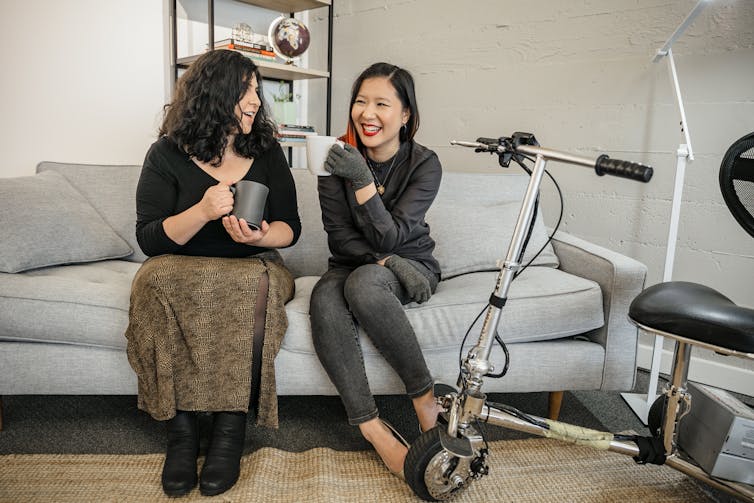
Australia is lagging behind other countries when it comes to employing people with disability.
A gulf exists between the employment rates of working-aged Australians with and without disability. The gap here is 32%, much higher than countries such as Sweden (9.5%), Finland (12.4%), France (9.9%) and Italy (13.3%).
Clearly, Australia needs to do a far better job of employing people with disability. My research, as someone with lived experience of disability, suggests disability services could be a good place to start.
Out of step with an inclusive ethos
A 2021 workforce census published by National Disability Services (NDS) – Australia’s peak body for non-government disability services – included new questions about the employment of staff with disability.
Our research team analysed the responses. They indicated many Australian disability services don’t include people with lived experience of disability among their workforce. In fact, almost a quarter of the 288 disability services surveyed said they don’t employ anyone with disability.
Further, only 24% of the organisations said they had someone with disability on their board. Even fewer organisations (19%) employed people with disability in management positions.
This fresh data is timely given the Albanese government’s election promise to include more people with disability as board members and in senior roles. In September, the government appointed Kurt Fearnley as National Disability Insurance Agency chair, along with two new directors: Graeme Innes (former disability discrimination commissioner) and Maryanne Diamond (Australian Network on Disability board member). The appointments brought the number of people with disability on the NDIA board to five.
But with lots of “don’t know” and “we don’t keep records” responses to the NDS census questions, it appears many disability service organisations are not collecting data about employees with disability. By not investing in this data collection, organisations are sending a message they don’t value disability as a part of diversity or inclusion.
This message is out of step with an inclusive ethos which celebrates the contributions Australians with disability make in our communities.

Read more: A disabled NDIA chair is a great first move in the NDIS reset. Here's what should happen next
Policy is soft
The NDIS Workforce Capability Framework, which will be rolled out this year, and the NDIS National Workforce Plan: 2021–2025 both recommend employing more people with disability. But both national polices are limited to “soft statements” rather than the steps required to achieve this goal.
For example, the NDIS National Workforce Plan recommends educators promote the demand for disability service workers. This might encourage job seekers with disability to apply. But these kinds of indirect policy approaches lean on the goodwill of the disability services sector.
This soft policy approach also fails to value and support the untapped work potential of people with disability in a sector that is experiencing significant workforce shortages.
Within the disability services sector, lived experience should be valued as a key capability. The National Workforce Plan should be forthright in actions to harness the skills, knowledge and experience of people with disability for roles across the sector.
The Albanese government could also look to its current review of the 1986 Disability Services Act as a legislative mechanism to enforce inclusive action.
Through non-compliance taxation, where companies have to pay additional taxes if they do not employ sufficient numbers of people with disability, the Australian government could encourage disability service organisations to meet disability employment quotas. Initiatives like this have been implemented in many other countries including Italy and France
Quotas are aligned with the concept of “affirmative action”, which aims to achieve equality for groups of people who have historically experienced discrimination, especially in areas such as employment and education.
Alternatively, service providers who currently receive National Disability Insurance Scheme funding could be registered with a condition that requires compliance with disability employment quotas.
Expect initial resistance
Our research underlines the need for strong policy measures to employ more people with disability. Disability service and leadership roles are a logical place to start this process.
Disability service organisations are missing out on a range of benefits that come from employing more people with lived experience of disability. These benefits include improvements in productivity, staff morale and organisational culture.
The introduction of disability employment quotas might encounter initial resistance. But if the Australian government is serious about improving employment prospects for people with disability, including career prospects within disability services, it will need to take affirmative action.
Correction: This article originally stated the 2021 NDS workforce census was its most recent. A subsequent census was published in 2022, which reported similar figures.
Damian Mellifont receives funding from NDS.
Jen Smith-Merry receives funding relevant to this article from National Disability Services, the Royal Commission into Violence, Abuse, Neglect and Exploitation of People with Disability, Independent Community Living Australia, the National Health and Medical Research Council, the National Disability Insurance Agency, the NSW Department of Education, the National Disability Research Partnership, Community Options Australia, the Canadian New Frontiers in Research Fund and the Department of Foreign Affairs and Trade.
Kim Bulkeley receives funding from the Australian Research Council; Monash University; ASPECT; MacKillop Family Services; NDS. Kim is affiliated with the Centre for Research Excellence - Disability and Health. Kim is on the Practice Governance Committee for Life Without Barriers. Kim is the president of Disability SPOT.
This article was originally published on The Conversation. Read the original article.
!["[T]he First and Fifth Amendments Require ICE to Provide Information About the Whereabouts of a Detained Person"](https://images.inkl.com/s3/publisher/cover/212/reason-cover.png?w=600)






